Fancy finding flirty flamingos in February?
What do romantic flamingos look like? It's the season for fabulous flirtation and lots of dancing and the flamingos start to perform their courtship displays.
February- the month of Valentine's Day and romance in the human and animal kingdom. It's the month that normally kicks-off peak flamingo dancing at Slimbridge and the other WWT centres that house our flamingo flocks.
In front of the WWT Slimbridge restaurant, the Caribbean flamingos are putting on some very loud and very vibrant courtship display that offer some great close-up views of life in the flock. The Andeans are performing their famous tightly-controlled marching. And the lesser flamingos are preening their long plumes and grunting (I can't think of a better description) in an amorous way at each other, all in the name of love.
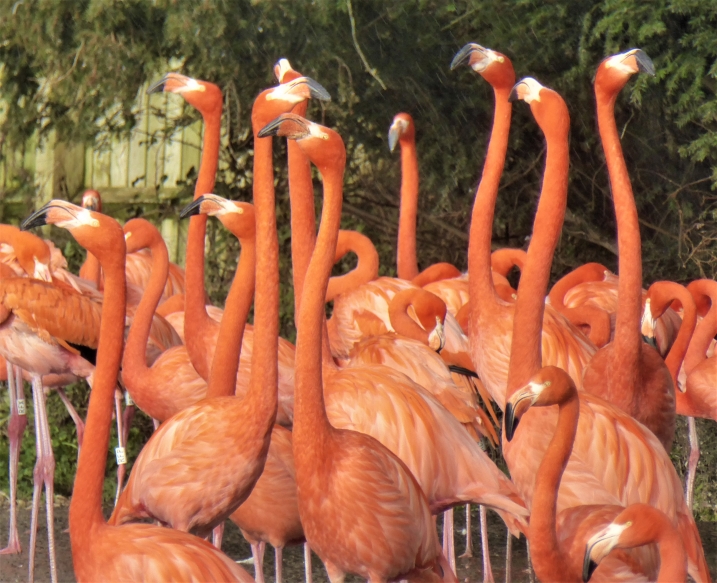
Flamingo courtship is a mixture of posture (very upright!), plus different head and wing movements, and often culminates in birds all rushing together in the same direction. The basic format of a courtship display can be seen in this video of the Caribbean flamingos.
Who really is the Greatest Dancer?
Lessers and Andeans do it best. Caribbeans try hard but are a rabble. If you want to judge some flamingo dancing for yourself, now is the time to visit. You can get some great views of the birds displaying if you are patient and spot the signs that means our flamingos are about to dance. Things to look out for:
- Lots of milling around as birds try to get each other in the mood for some dancing.
- Heads in the air. Birds stretch their necks tall and flag their heads from side to side.
- Extra preening as flamingos get their feathers looking in tip-top condition.
- Groups of flamingos standing close together and all acting in the same way.
- Noise! Lots of high-pitched honking or gabbling as the birds work themselves up into a dancing frenzy.
Just like your average primary school disco or first school dance, when everyone crowds around the walls waiting for someone to take the plunge, it takes one or two brave and outgoing individuals to encourage the other birds to start dancing too. And it can be a pretty empty dance floor to fill at the beginning of the breeding season!
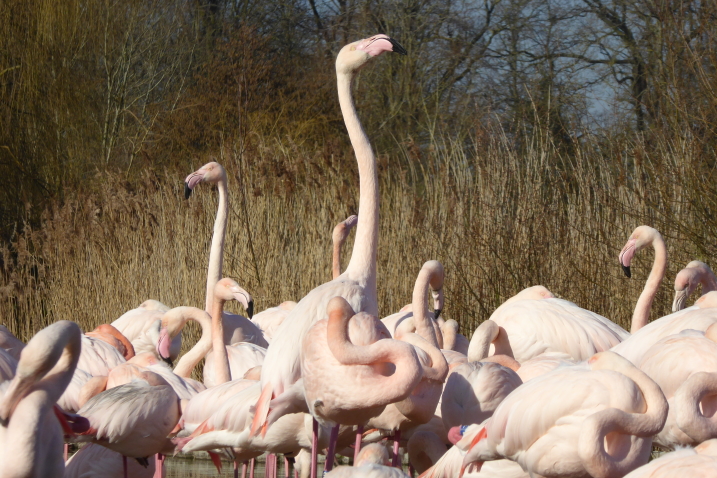
A sure sign that someone is going to dance. This tall, male greater flamingo is stretched above the rest. Standing very stiff and upright, he will move his head from side to side, trying to catch the attention of other birds who might be interested in joining in the dancing too. See his attempts to spread the love of dancing around his friends in this video.
Why so much effort?
Flamingos are one of the most vibrantly coloured of birds. They put a lot of effort into their feather colour and plumage condition. Therefore they want to attract a partner who is just as stunningly pink and beautiful as they are. So the dancing helps them decide who is as fit and strong, as vibrant and as pink. As all birds who wish to nest join in the dancing together, flamingos coordinate their breeding to occur at the same time for everyone. This gives breeding birds extra protection and more chance for chicks to fledge (leave the nest) successfully.
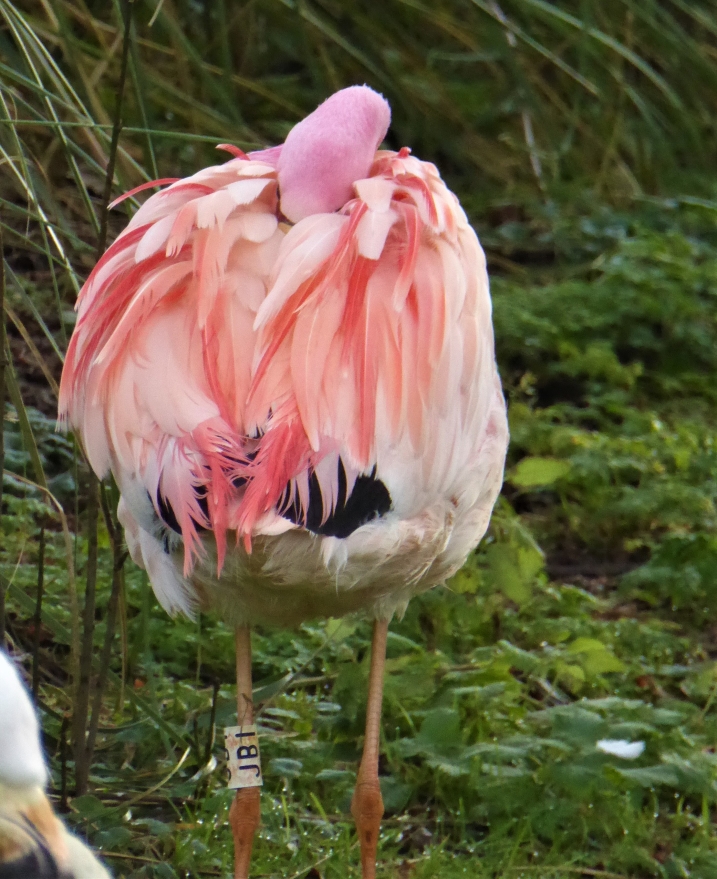
There's only one Mr James but even he, at this time of year, gets dressed in his best and spends a long time preening and washing his plumage. The long red plumes (called scapular feathers) that drape over his wings are an important part of his breeding dress. He also sports a deeper pink head and neck and brighter orange legs.
The harsh environments that flamingos have evolved for means they have a real need to keep their feathers in good order for their health and well-being. Because flamingos use the pink pigments from what they eat to colour their feathers specifically to show off how attractive they are to potential mates, they must also keep their feathers clean and well-preened so this visual effect does not diminish.
Consequently, during the courtship season, you will see more preening and more bathing in our flamingos. It is common for bathing and boogieing to occur together- flamingos have a wash and brush-up before another whirl around the dance floor. You can see this happening in this video of the Caribbean flamingos at WWT Slimbridge.
Some slightly weird dance moves
Whilst some dance moves are common across flamingo species, like the head flags and stretching out wings to salute, some courtship behaviours are slightly more special to particular flamingo types. And these can look a little odd. Caribbean and lesser flamingos indulge in something called a "broken neck display", which you can see in the photo below.
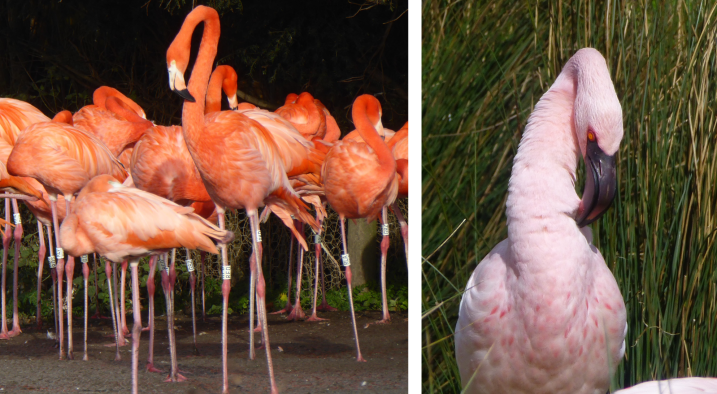
This behaviour occurs when the birds are head-flagging or marching, and does not look at all comfortable! We are unsure why the birds contort themselves in this way, but it must have some benefit in making one flamingo look more attractive to another, otherwise why would they bother to do it?! You can follow the lesser flamingos in this video as they do this "broken neck" action during their dance.
The WWT Slimbridge flamingos are currently looking in tip-top condition, and with the moody winter weather and big skies that we have been experiencing, you can get some really amazing photos of these birds in this very special wetland setting. Especially when the weather throws a rainbow (or two) across the top of some dancing Caribbeans :-)
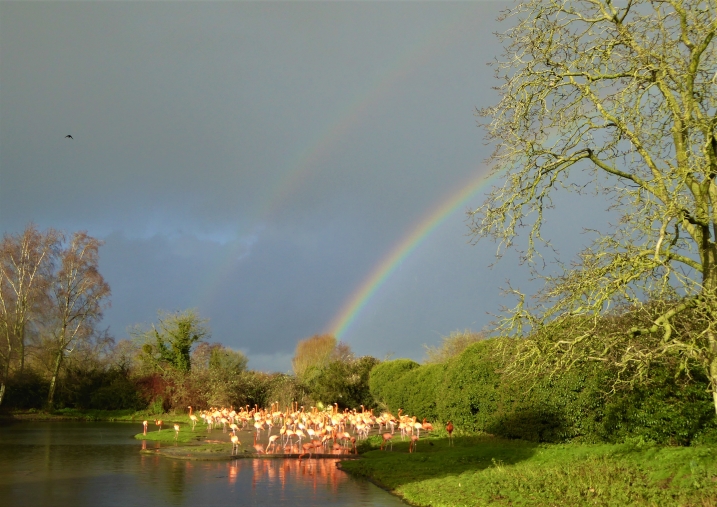
Good luck spotting the flirty flamingo foxtrot on your next visit!



